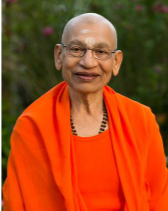
Spirituality: ‘Samatva Dristi’ – The vision of Oneness

By Swami Viditatmananda Saraswati*
The Destruction of the Self
In the Bhagavad Gītā, Lord Krishna points out that the Self is ageless, immortal, and indestructible. Weapons cannot cut it, fire cannot burn it, water cannot wet it or drown it and air cannot dry it. How can it even be hurt, much less destroyed? And would anyone hurt his or her own self?
Because the self cannot be destroyed or hurt in the primary sense, we have to take the secondary meaning of the word ‘destroy’ or ‘hurt’. Destruction can be of many types. Here it would mean ‘lack of respect’ or ‘misuse’ or ‘abuse’. When you show disrespect or falsely accuse an extremely respectable and respected person, it is as good as killing the person.
The self is sat-cit-ānanda – changeless, immortal, aware, limitless, whole. Yet because of ignorance, one superimposes mortality, ignorance and limitation on the self. This non-recognition of the truth of the self is disregard and denial of the true self. This is the destruction of the self.
This non-recognition of the true nature of the self leads to discontentment with one’s own self, which causes one to beg for happiness, peace and security from the world. This seeking of security and adequacy in the world is a big denial of one’s self alone, which is the destruction of the self.
Destruction of the self comes in many forms. The Lord resides as the self in every being. So whenever we snub or harm anyone through thought, word or deed, we are only showing a lack of respect for the Lord who dwells in that heart.
Again, because of ignorance alone, we misuse the body, by using it for sense gratification and aggrandizing material wealth, mistaking these as the goals of life. To use it for sense pleasures alone is definitely misusing it and is comparable to destroying oneself.
There is the destruction of the self again when our actions are contrary to universal values of righteousness, peace and truth, which are in keeping with the nature of the self. In this way, there is a denial of the Lord, the self who is in the form of dharma.
Thus, there is a sequence in how we destroy the self:
• Owing to ignorance there is aviveka (lack of discrimination)
• As a result of aviveka there is desire (for security and pleasures)
• From the desire for security and enjoyment, arise likes and dislikes.
• From these likes and dislikes arise the impulses of anger, greed, lust, etc.
• These impulses lead one to do wrong actions.
If action is performed for the sake of material achievements and satisfying one’s senses alone, yet is in keeping with ethics, one still misses the goal of life and misuses the self in the form of the body.
The Vision of Oneness – the End
The wise person, who recognizes that oneness is the Truth, is free of the kinds of destruction mentioned above. Lord Krishna describes how the wise person perceives the world:
vidyā-vinaya-sampanne brāhmane gavi hastini
śunicaiva śvapake ca panditāh samadarśinah
Wise people see the same self in a Brahmin endowed with knowledge and humility, in a cow, in an elephant, in a dog and (even) in a dog-eater (B.G. 5.18).
Here Lord Krishna gives examples that show the different proportions of the gunas of sattva, rajas and tamas. The Brāhmin endowed with knowledge and humility is an example of sattva. Here the use of the word Brāhmin only indicates a sāttvic person and not a particular case or person. Where there is a predominance of sattva, there will be śama (mastery over one’s mind), dama (mastery over one’s sense organs) and tapas (austerity), as well as purity, faith, knowledge, etc.
The ‘cow’ is an example of the predominance of rajas. The other examples all indicate a predominance of tamas, which shows slowness, dullness, ignorance, insensitivity, and cruelty.
These differences manifest clearly in terms of appearance, deeds, character and instincts. The wise person notes not only the differences obtaining at the level of the upādhi but also the Truth, the Lord and the inherent unity in all of them.
About this Truth or reality, the Lord says:
nirdosam hi samam brahma
Since Brahman is without any blemish and is equal in all (B.G. 5.19).
Brahman or the Lord has no defect, no blemish, and is equally present in the whole universe. This is again said in a different place in the Bhagavad Gītā:
samah aham sarvabhūtesu na me dveśah asti na priyam
I exist equally in all beings. There is no one for whom I have a dislike, nor do I have a favourite (B.G.9.29).
The Lord says that I am the self of every object, be it sāttvic, rājasic, or tāmasic. I reside equally in a virtuous person, an immoral person, a believer, a rich person, a poor person, and so on.
Now, a question naturally arises. If the Lord is equally present in both the pure-hearted and the impure-hearted, does the Lord get tainted by impurity? The Lord says, ‘No”. The Lord sustains and lends support to the upādhis and their qualities by mere presence alone, and is totally free of the merits and demerits of the upādhis. Just as the sun does not get purer because it is reflected in the waters of the Gangā, nor does it become impure when it is reflected in dirty water, so too the Lord, who is the self of a sāttvic person, does not become purer when reflected in this person, nor does the Lord become tainted with impurity, even though He is the self of a person given to wrong thinking.
Again, another question arises: do the merits and demerits of the upādhis conceal the Lord? If they do, then how can the wise man see the Lord in and through the disparities caused by the upādhi? In this case, the Lord says that ‘the upādhis cannot hide me. I am the consciousness that is self-revealing and so, I am ever evident (as the self)’. The self itself is free of all merit upādhi with all its qualities is a medium free of all qualifications. In fact, this manifests the self.
An ignorant person does not take the self-shining, self-revealing self into account. Instead, his mind is always engaged in giving reality to merit, demerit, virtue, and vice because he takes the upādhi itself to be the self.
However, the wise man, who has the capacity to discriminate between ātmā and anātmā, recognizes the self is free, is satya – the truth which is ever uninvolved, whereas the upādhi is only a costume that does not have the capacity to touch the self. In the wake of this recognition, he is not swayed by the good or bad attributes of the upādhi. He sees that which is free of all attributes, in all the attributes. He perceives the formless in all that has form. The person who sees the one in the many, the unity in the diversity, the permanent in the impermanent – he alone sees.
The wise man is non-violent. The wise person knows himself and everything else to be of the nature of sat-cit-ānanda. He is content with himself and does not depend upon anything else for happiness and joy. He alone really respects the self. As a result, he does not harm himself because of the denial of the self. Again, he does not judge a person merely by the upādhi and therefore he respects others, too. He sees everybody as equal to himself. In the Bhagavad Gītā, the Lord says:
ātmaupamyena sarvatra samam paśyati yah Arjuna sukham vā yadi vā duhkham sa yogīi paramah matah
The one who judges happiness and sorrow in all beings by the same standard as he would apply to himself, that yogi, O Arjuna, is regarded as the most exalted (B.G. 6.32).
A wise person recognizes his own self as the self of all. As a result, he applies to everyone else the same standards that he applies to himself. He appreciates that just as he likes happiness and dislikes unhappiness, so too, do others also like happiness and try to avoid unhappiness. Knowing this, he does not harm anybody physically or psychologically. Moreover, he makes every effort to secure beneficial situations for others.
While he definitely perceives the differences obtaining at the level of the upādhi, and he respects these differences while dealing with situations, he nevertheless does not have any sense of reality in duality. His recognition that the Lord is there equally in all always remains.
The love of wise people who live by ahimsā is not confined to any one race or people of one nation. Caste, race, religion or nation does not shackle their love and compassion. The intention behind all their transactions is love, compassion and the blessing of well-being to all.
..tatah yāti parām gatim
..because of this he attains the ultimate goal (of moksa) (B.G. 13.28).
He is liberated while living. The bondage that one feels is only a notion that arises from ignorance. Taking differences and duality to be real leads to many complexes which manifest as the defence mechanisms of desire, greed, and anger.
A person seeking to reach the highest pinnacles of love, compassion and happiness finds the commitment to race, caste and region as binding chains that block spiritual growth. With great determination, he breaks these fetters, one by one, and discovers the inner freedom in which the external world is unable to create any bondage or dependence. The wise person becomes free while in this body itself. This inner freedom born of recognizing the truth of oneness is the goal of life.
to be continued…
*Swami Viditatmananda Saraswati has been teaching Vedānta Prasthānatrayī and Prakaraṇagranthas for the last 40 years in Ahmedabad, Gujarat. Throughout the year, he conducts daily Vedānta discourses, accompanied by retreats, and Jñāna Yajñas on Vedānta in different cities in India and in foreign countries.





